Derby porcelain figure of female Ranelagh dancer, 1759-1769
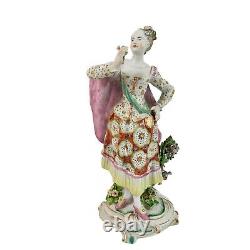
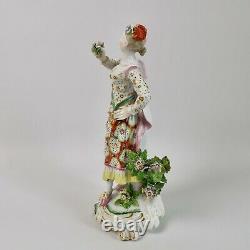
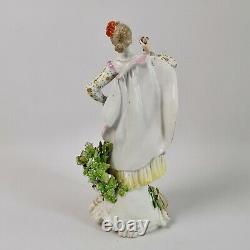
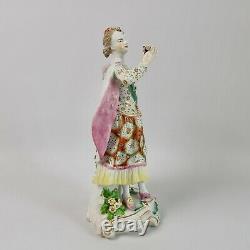
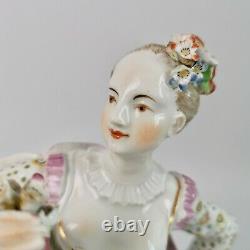

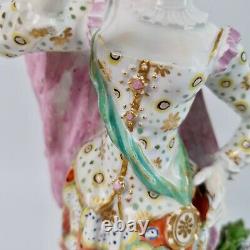
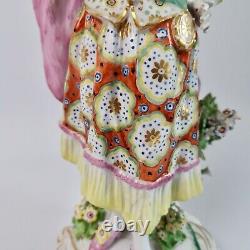
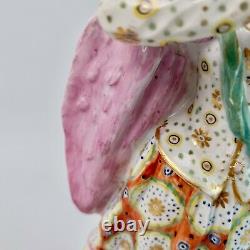


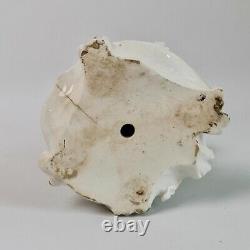

This is a sublimely made porcelain figure of the female "Ranelagh Dancer", made by Derby between 1759 and 1769, which was the Rococo era. The figure would originally have had a male companion but she is fabulous just by herself. The Derby Porcelain factory has its roots in the late 1740s, when Andrew Planché, a Walloon Huguenot refugee, started making simple porcelain toys shaped like animals in his back yard. The combination of various traditions, porcelain making skills and sophisticated clients enabled Duesbury to create one of the best porcelain factories of the 18th and 19th Centuries, which after many ups and downs is still operative today. The "Ranelagh Dancers" were a popular pair of figures inspired by a famous masked ball in the Ranelagh Gardens in Chelsea, and carry the Derby number E17. This figure forms part of what is called the "patchmarked" era. On 24 May 1759, a masked ball was held in Ranelagh Gardens, Vauxhall [sic, this should be Chelsea, which had the most popular pleasure ground, while Vauxhall was the second most popular pleasure ground] to commemorate the birthday of Frederick George, Prince of Wales. The colourful and often bizarre costumes of the guests prompted several contemporary engravings and one of these probably inpsired some dozen Chelsea models that were made. Only two Ranelagh Dancers (E17) were created at Derby - a gallant...
And a lady clad in a mantle and Court dress with plumes in her hair; the cameo suspended on a ribbon from her shoulder is believed to have been the token of admission to the festivities. This dancer has been made with exceptional care; her physical posture, noble expression on her face, and beautiful clothes including a fur cape! All speak of the highest level of attention.
Figures like these were used to adorn the dinner table when dessert was served; groups of figures could serve to express something about the host, the guests, or to direct the conversation. Dancers and musicians were popular among these figure series. The figure is unmarked as is usual for figures of this particular era. CONDITION REPORT: The figure is in excellent antique condition with some minor flaws. She has lost the tips of the fingers of her left hand; the feathers have been broken from her head; she has lost some of the flowers in her right hand and there are some missing flower petals to the bocage.There is some very light crazing here and there and there is a firing crack through the base, which is from production and does not affect its stability. Other than this there is very little wear and I have not detected any repairs.
If desired we can arrange excellent restoration at cost to make the figure perfect again, however as restorers are currently very busy this could take several months to arrange. Antique British porcelain is never perfect. Kilns were fired on coal in the 1800s, and this meant that china from that period can have some firing specks from flying particles. British makers were also known for their experimentation, and sometimes this resulted in technically imperfect results. Due to the shrinkage in the kiln, items can have small firing lines or develop crazing over time, which should not be seen as damage but as an imperfection of the maker's recipes, probably unknown at the time of making. Items have often been used for many years and can have normal signs of wear, and gilt can have signs of slight disintegration even if never handled.I will reflect any damage, repairs, obvious stress marks, crazing or heavy wear in the item description but some minor scratches, nicks, stains and gilt disintegration can be normal for vintage items and need to be taken into account. There is widespread confusion on the internet about the difference between chips and nicks, or hairlines and cracks. I will reflect any damage as truthfully as I can, i. A nick is a tiny bit of damage smaller than 1mm and a chip is something you can easily see with the eye; a glazing line is a break in the glazing only; hairline is extremely tight and/or superficial and not picked up by the finger; and a crack is obvious both to the eye and the finger. DIMENSIONS: Height 29.5cm (11.6"), 12.5cm (5") wide and 13cm (5.2) deep.
This item is in the category "Pottery & Glass\Decorative Pottery & Glassware\Figurines". The seller is "rattlethecups" and is located in this country: GB. This item can be shipped worldwide.
- Handmade: Yes
- Colour: Multicoloured
- Country/Region of Manufacture: United Kingdom
- Style: Rococo
- Material: Bone China, Ceramic, Porcelain
- Theme: Dancer
- Type: Figure
- Features: Date-Lined
- Antique: Yes
- Year Manufactured: 1759
- Subject: Shepherdess
- Origin: British
- Brand: Derby
- Original/Licensed Reproduction: Original
- Time Period Manufactured: 1750-1799
- Era: Georgian (1714-1837)

